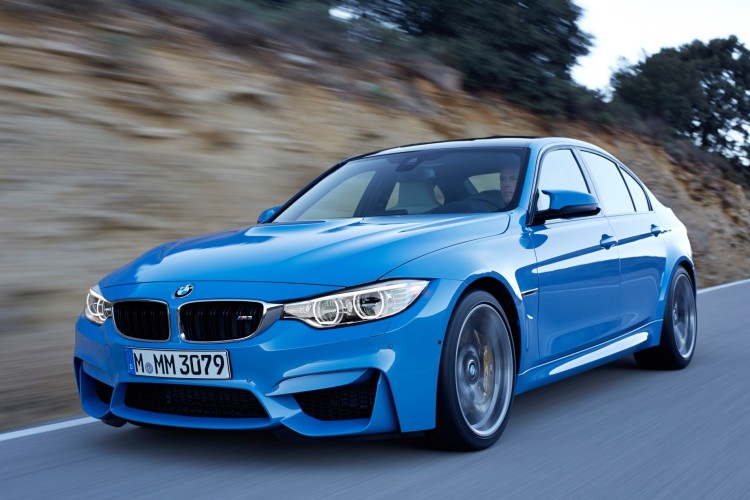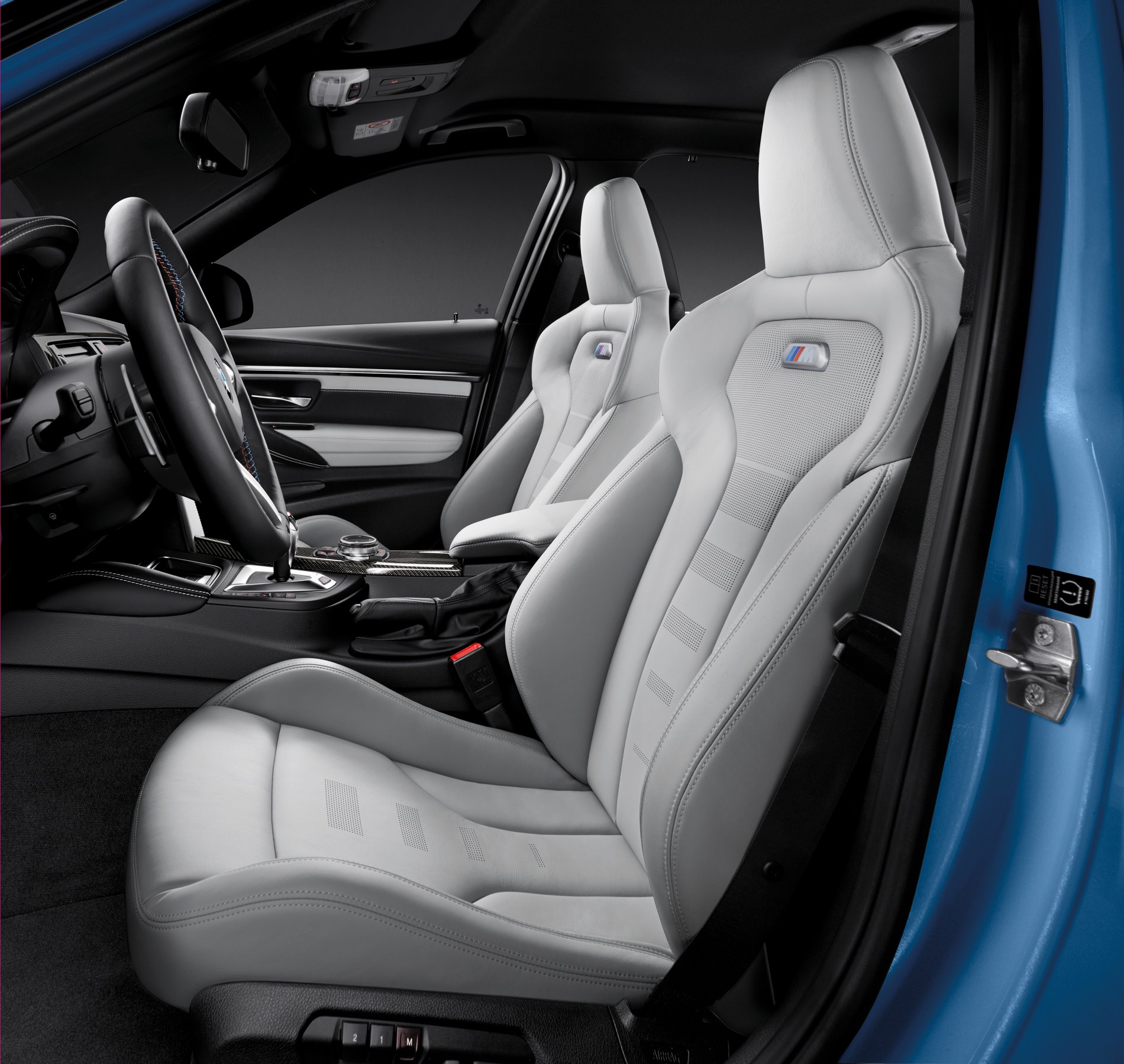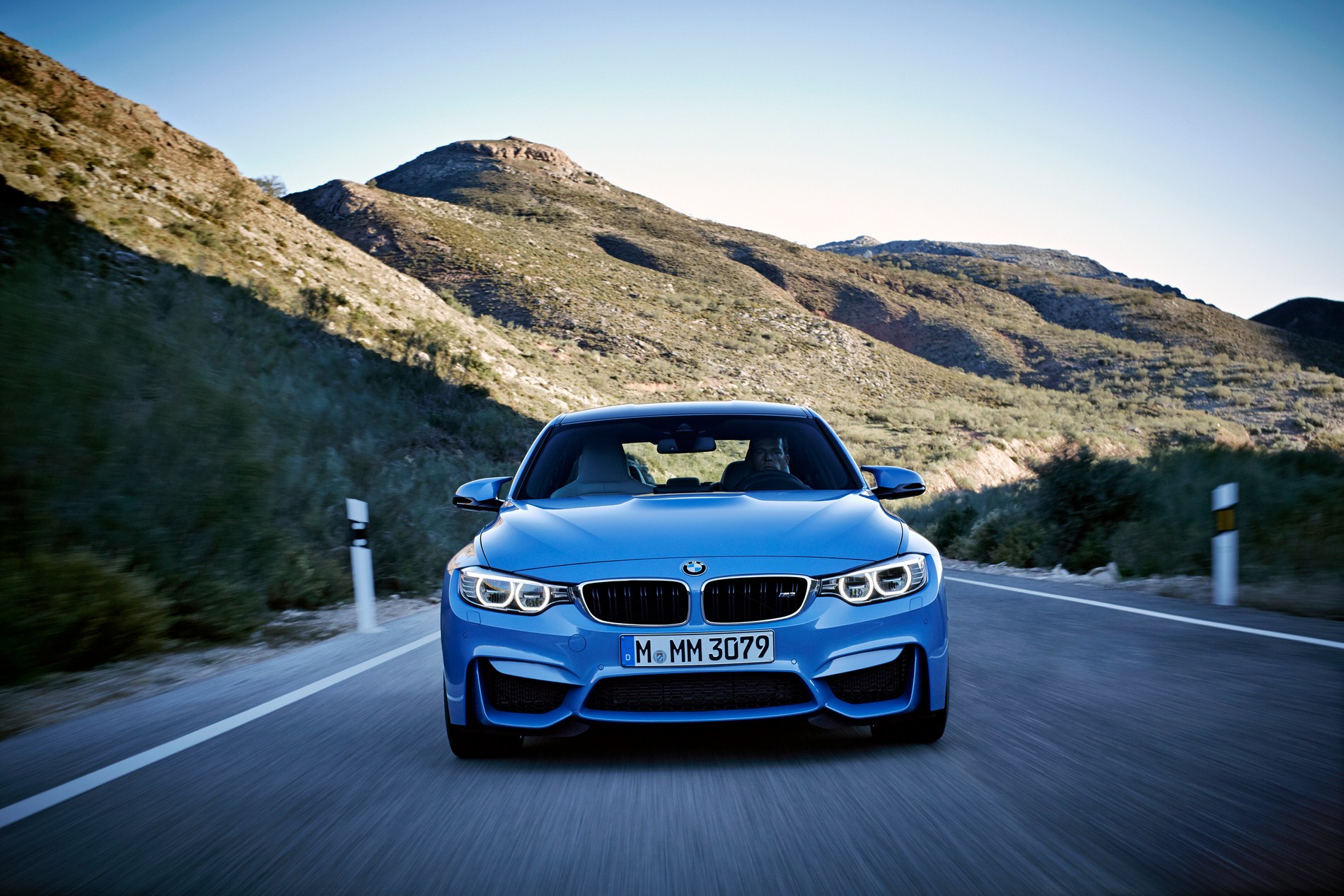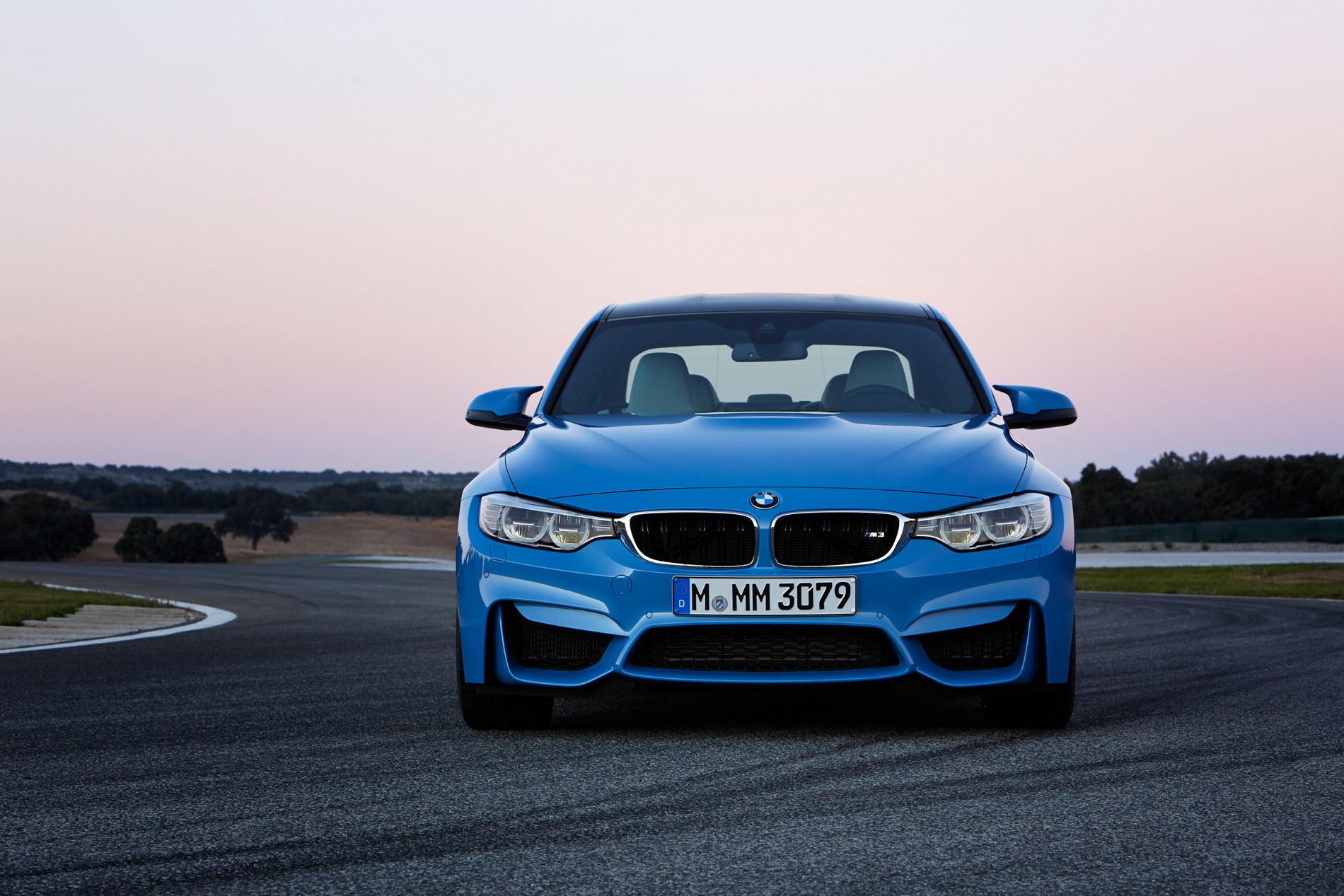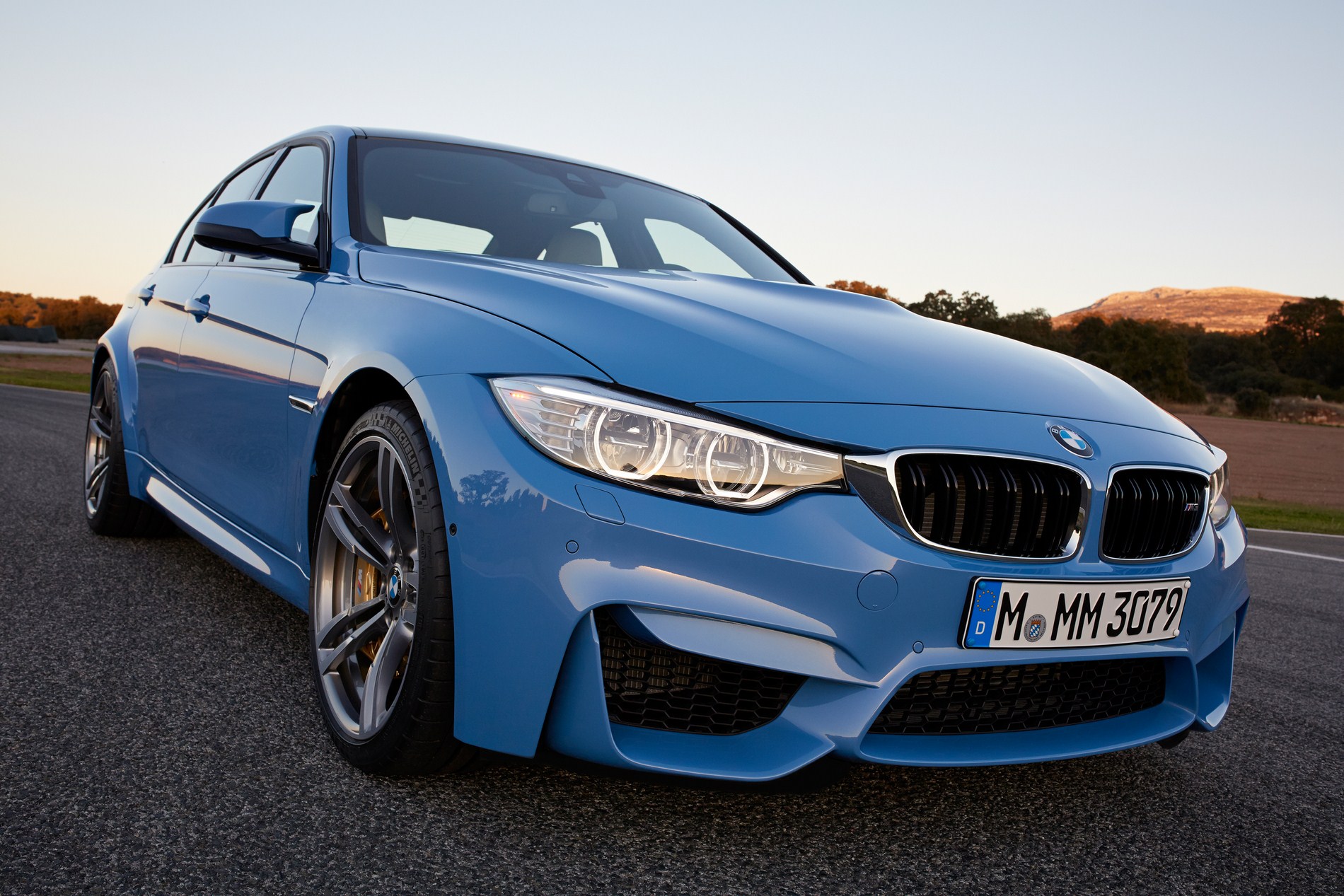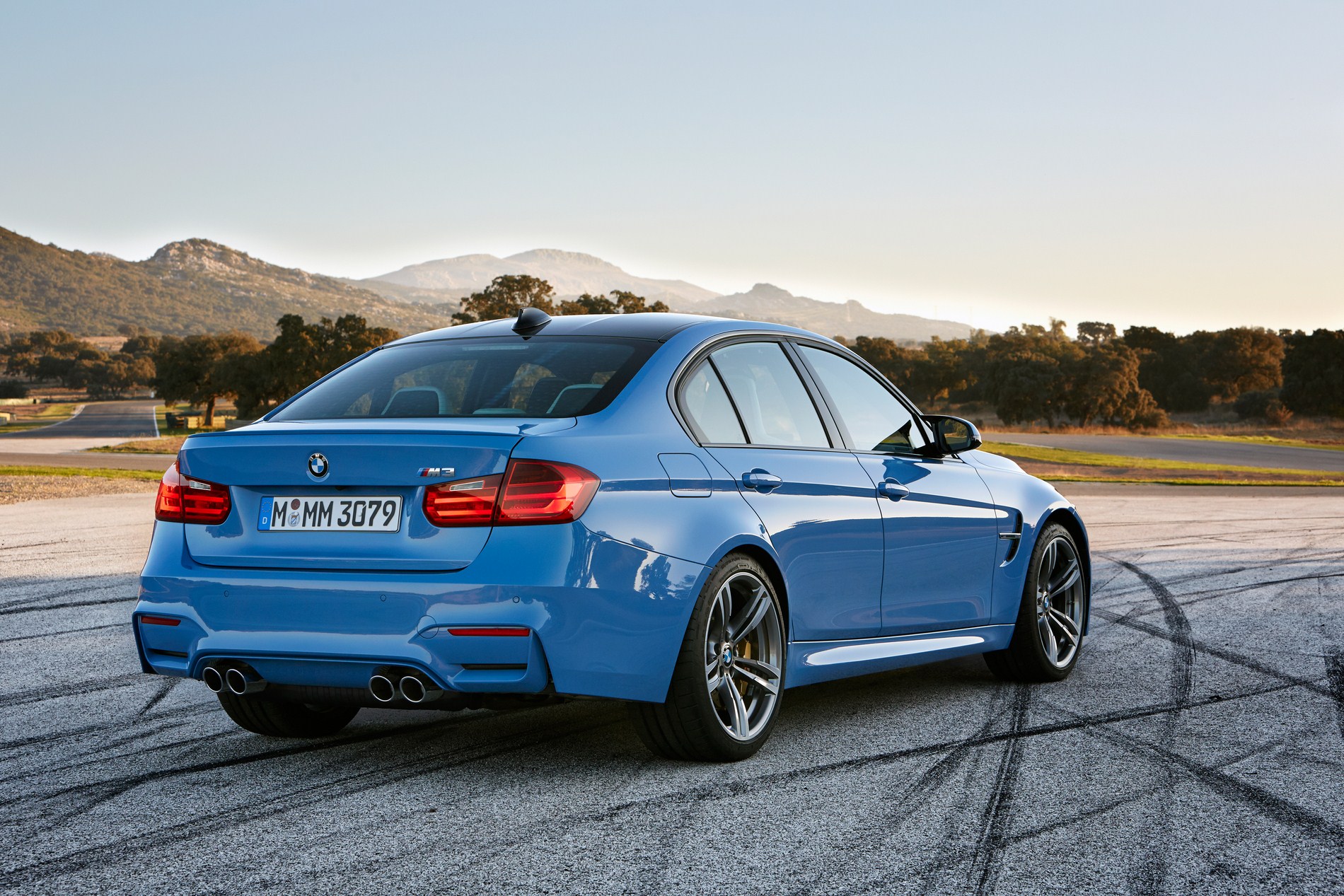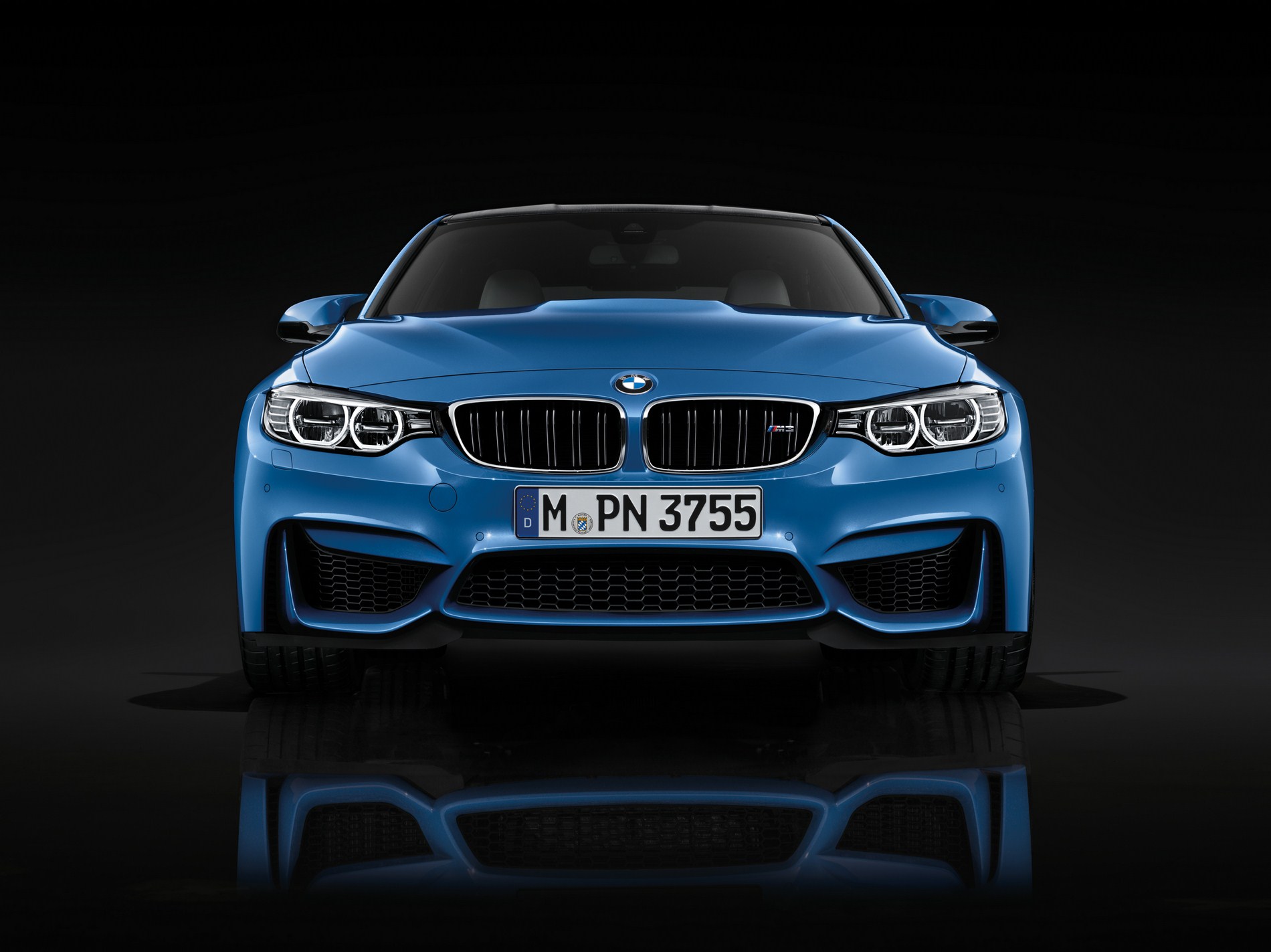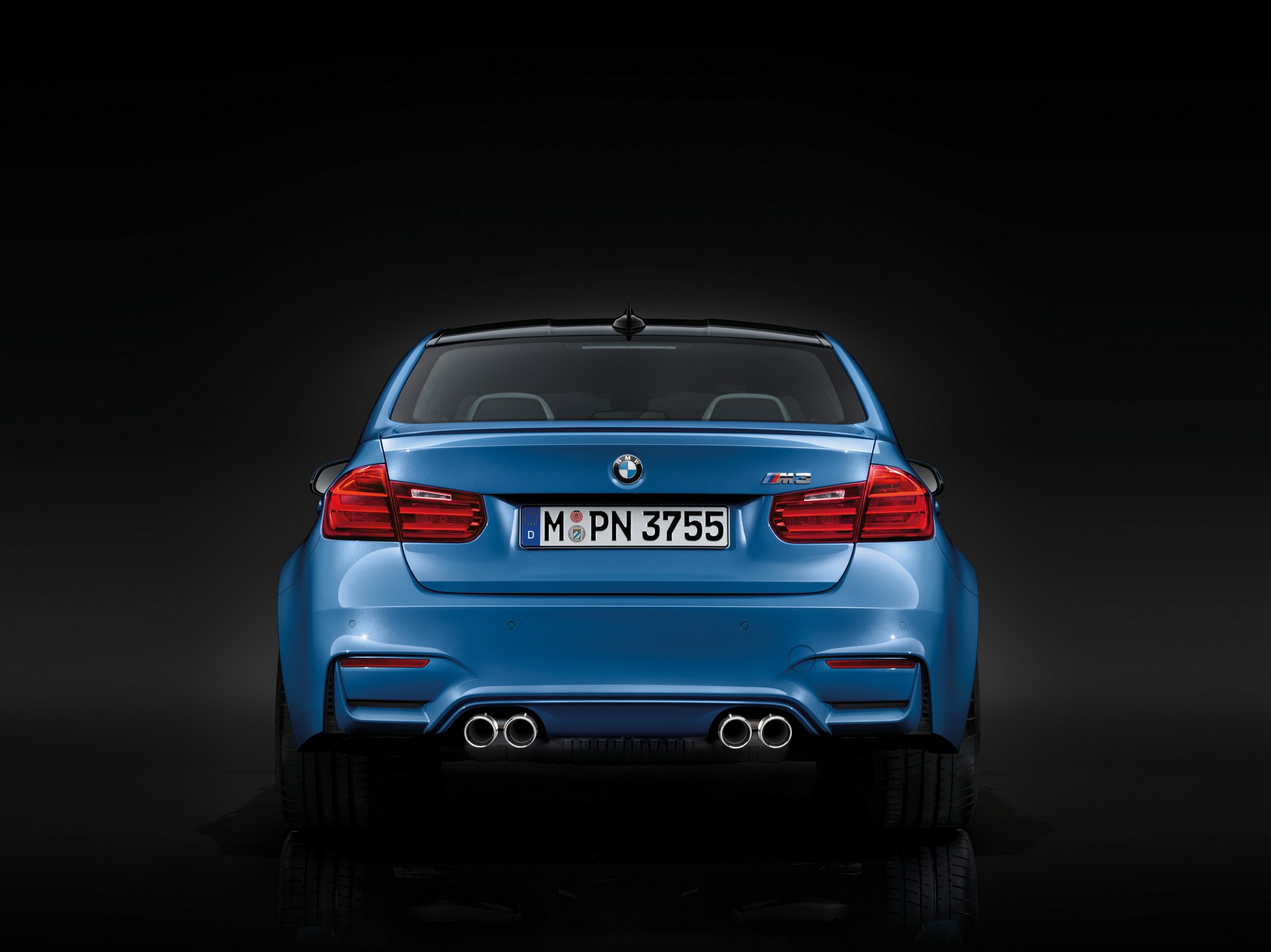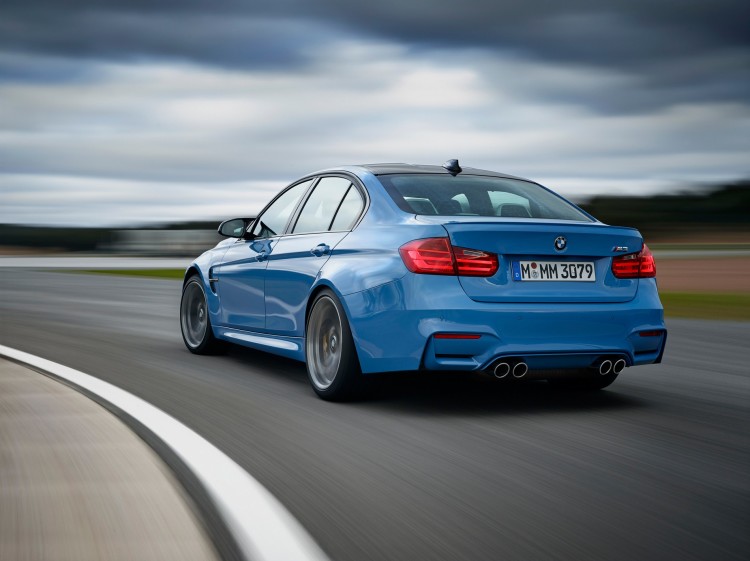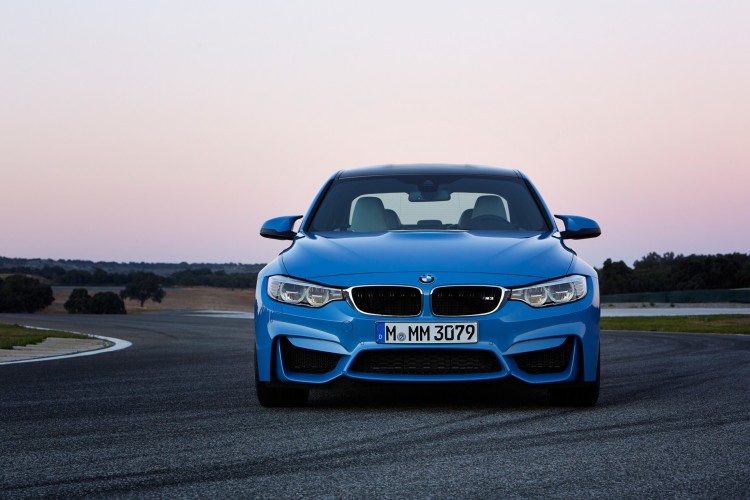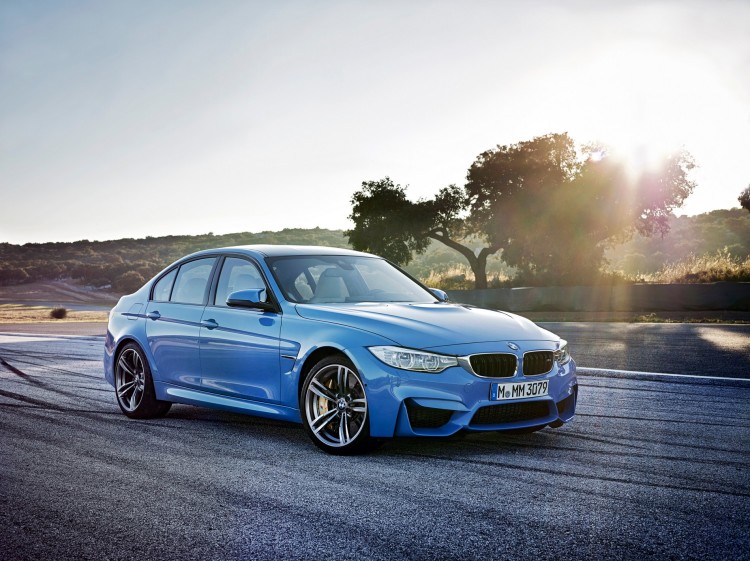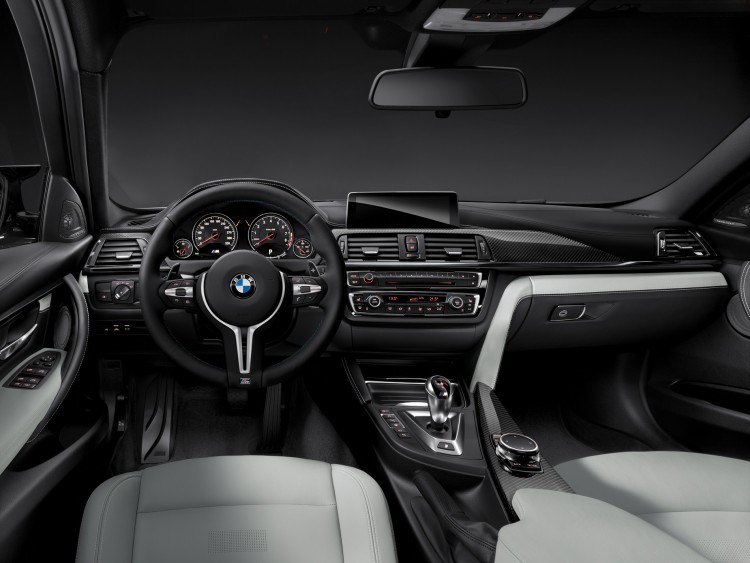The launch of the new BMW M3 Sedan and new BMW M4 Coupe sees BMW M GmbH revealing a new interpretation of the high-performance sports car – and carrying the BMW M philosophy over into the fifth generation of the M3. More than 40,000 examples of the fourth-generation BMW M3 Coupe were built, and now the BMW M4 Coupe is poised to continue this success story. The “M4” badge is a reference to the model series that provides the basis for the new M model – and, for the first time, the Coupe will be introduced at the same time as the four-door variant. Logic dictates the latter will be christened the BMW M3 Sedan.
“Four generations of the BMW M3 have blended motor sport genes and uncompromised everyday usability within an emotionally rich overall concept,” explains Dr Friedrich Nitschke, President BMW M GmbH. “The BMW M3 Sedan and BMW M4 Coupe represent an ongoing commitment to this philosophy. The engine is the heart of every M model, and the new turbocharged six- cylinder unit fitted in the two new cars combines the virtues of a high-revving naturally aspirated unit with the strengths of turbocharger technology. A committed lightweight design concept produces a weight saving of around 80 kilograms over the outgoing M3. The BMW M3 and BMW M4 take motor sport technology from the track to the road, and thousands of laps of the legendary Nürburgring Nordschleife – the world’s most exacting race track – have readied the new models for that transition. Meticulous and passion- fuelled development work has underpinned the creation of two high- performance sports cars that set new standards in terms of overall concept, precision and agility.”
The high-revving six-cylinder in-line engine with M TwinPower Turbo technology newly developed for the new BMW M3 Sedan and new
BMW M4 Coupe produces a maximum output of 431 hp. Its peak torque of 550 Newton metres (406 lb-ft) is available across a wide rev band and outstrips the figure recorded by the outgoing BMW M3 by roughly 40 per cent. And yet the engine also achieves a reduction in fuel consumption and emissions of around 25 per cent. Both the BMW M3 Sedan and BMW M4 Coupe cover the sprint from 0 to 100 km/h / 62 mph in 4.1 seconds (with the optional seven-speed M Double Clutch Transmission).
In the interests of maximising dynamic ability and ensuring excellent efficiency, weight savings of around 80 kilograms have been achieved over a comparably equipped predecessor model. The BMW M4 Coupe, for example, has a DIN kerb weight of 1,497 kilograms, thanks to the rigorous application of intelligent lightweight design measures. These include the increased use of lightweight materials such as carbon-fibre-reinforced plastic (CFRP) and aluminium for a number of chassis and body components. Indeed, both models feature a carbon roof.
One of the primary objectives in the development of the BMW M3 Sedan and BMW M4 Coupe was to ensure the new cars offered impressive race track capability. Hence the presence of a track-specification cooling system, which ensures that the optimum temperature balance for the engine, turbochargers and transmission is maintained at all times.
In order to accentuate the racing character of the two models in terms of both their technical composition and the fine-tuning of the cars, the engineers worked closely with BMW Motorsport’s professional racing drivers during the development phase. For example, DTM drivers Bruno Spengler and Timo Glock took part in the extensive testing and set-up work carried out at the Nürburgring-Nordschleife circuit.
The balance of the overall concept: A blend of elements working in perfect harmony delivers outstanding performance, precision and agility.
Low-slung and broad-set, the new BMW M3 Sedan and new BMW M4 Coupe share a finely balanced stance on the road. Indeed, the M-specific design of the two high-performance sports cars underlines their performance capability. Large air intakes and Air Curtains at the front end, exposed carbon-fibre- reinforced plastic (CFRP) and aluminium body components, and the diffuser at the muscular rear end are not merely design flourishes; they also fulfil functional roles in terms of aerodynamics, cooling and weight saving.
Numerous aerodynamics measures integrated into all areas of the body.
The aerodynamics concept of BMW M GmbH models has always been one of the key elements in their development. The engineers need to channel the air around the car to create the best possible platform for dynamic excellence, while also ensuring the engine, powertrain and brakes receive the requisite cooling even when operating under heavy loads on the race track.
Details such as the powerfully formed front apron, smooth underbody and clearly defined Gurney spoiler at the rear of the M3 Sedan (or integrated spoiler lip at the rear of the BMW M4 Coupe) reduce lift by an equal degree at the front and rear axle and produce optimum handling attributes. “The way in which we channel the inflowing air through the engine oil cooler creates a Venturi effect, which reduces front axle lift and, in so doing, improves the steering,” explains Albert Biermann, Head of Development BMW M GmbH. Elements like the Air Curtain and M gills with integrated Air Breather rearwards of the front wheels minimise turbulence in the front wheel arches. Together with the aerodynamically optimised exterior mirrors in twin-stalk style, they are also highly distinctive design features of the BMW M3 Sedan and BMW M4 Coupe and help reduce drag. These examples underline in familiar fashion the success of M engineers in reconciling the requirements of everyday use with the demands of action on the race track.
Sophisticated cooling concept for maximum performance.
The exceptional performance potential of the BMW M3 Sedan and BMW M4 Coupe places extremely exacting demands on temperature management in the engine and peripheral assemblies. In order to ensure optimum operating temperatures in everyday use, on short journeys around town and out on the race track, the BMW M GmbH engineers have developed an extremely effective cooling system. For example, alongside the two ultra- dynamic turbocharger units, the air intake system of the six-cylinder engine also includes an indirect intercooler, maximising charge pressure and engine output. As well as a main radiator, the track-ready cooling concept also comprises a water cooler repositioned to the side for the high- and low- temperature water circuits, and the engine and transmission oil (if the M Double Clutch Transmission is specified). These ensure a consistent temperature balance and therefore high performance on the track as well as the road. An additional electric coolant pump cools the turbocharger bearing mounts when the car is stationary.
Six-speed manual gearbox with throttle blipping.
The engine’s power is transferred to the road via a standard six-speed manual gearbox with robust double-plate clutch. This unit is considerably more compact than its predecessor and 12 kilograms lighter. As a means of increasing shift comfort, the manual gearbox uses innovative new carbon friction linings in its synchroniser rings. Dry sump lubrication provides an efficient supply of oil to all parts of the engine. The gearbox blips the throttle on downshifts – previously a feature reserved for the M Double Clutch Transmission. This engagement speed control function improves the smoothness of the transmission, helps to enhance stability and was originally developed by motor sport engineers.
Seven-speed M Double Clutch Transmission Drivelogic with Launch Control.
The third generation of the M DCT sees the M engineers once again setting the benchmark in terms of power and race track capability without having to compromise on everyday usability. The optional seven-speed M Double Clutch Transmission with Drivelogic prompts the new high-revving turbocharged engine into emotionally impressive feats. As well as changing gear automatically, in manual mode the transmission enables ultra-fast gear changes with no interruption in the flow of power. The integrated Launch Control function ensures optimum sprinting performance off the line, producing acceleration figures that would be out of range with the manual gearbox. The Smokey Burnout function allows the driver to indulge in a degree of rear wheel spin while the car is moving at low speeds. Stability Clutch Control opens the clutch when the car is understeering to bring it back into line. And M DCT also includes functions like the Drivelogic modes that can be selected by the driver to give the BMW M3 and BMW M4 more comfortable, more economy-focused or even sportier characteristics. The additional seventh gear over the manual gearbox allows longer gear ratios – and delivers the efficiency gains you would expect as a result.
The properties of the extremely light yet impressively durable material CFRP have allowed the engineers to follow a fundamentally new approach in the manufacture of the drive shaft. Made from CFRP, this component feeds the engine’s torque from the gearbox to the rear differential and works under extremely heavy loads – especially in high-performance vehicles. “The impressive stiffness and low weight of the CFRP tubing allow the drive shaft to be constructed as a single-piece unit with no centre bearing. As well as a weight saving of 40 per cent over its predecessor, we have achieved a reduction in rotating masses and therefore improved drivetrain dynamics,” explains Albert Biermann.
Even more accomplished rear-wheel drive with Active M Differential.
Among the other components that add fresh polish to the dynamic repertoire of the BMW M3 Sedan and BMW M4 Coupe are the hollow lightweight output shafts of the rear differential and the Active M Differential, which uses an electronically controlled multi-plate limited-slip differential to optimise traction and directional stability. The multi-plate limited-slip differential works with extremely high precision and speed. Its control unit links up with the DSC (Dynamic Stability Control) system and also takes into account the position of the accelerator pedal, the rotational speed of the wheels and the car’s yaw rate. Every driving situation is therefore precisely analysed and an impending loss of traction on one side of the car identified at an early stage. The degree of lock – which may be anywhere between 0 and 100 per cent – is adjusted as required within a fraction of a second, enabling wheel spin to be prevented on slippery surfaces, in instances where the right and left rear wheel have widely differing friction coefficients, in tight bends and when changing direction with particular vigour. Optimising traction in this way also provides unbeatable driving stability in challenging conditions and allows impressively dynamic acceleration out of corners.
M Dynamic Mode – a subfunction of the Dynamic Stability Control (DSC) system – quenches the thirst of enthusiastic drivers for keen dynamics. While DSC intervenes as required to counteract understeer and oversteer, M Dynamic Mode allows greater wheel slip and therefore easy drifting. Owners with a taste for sporty and dynamic driving will appreciate this breadth to the cars’ handling, although DSC will still step in if the car ventures over the limits – unless it is switched off completely. Whichever setting the driver chooses, he or she remains responsible for the car’s stability.
Aluminium suspension elements ensure sharper dynamics.
The core expertise of BMW M GmbH resides in developing M cars that offer impressive steering precision, on-the-limit adjustability, agility and driving feeling, together with unbeatable traction and outstanding directional stability – all without neglecting everyday usability. In order to achieve these aims with the significantly increased performance capability of the new BMW M3 Sedan and new BMW M4 Coupe, the axles of the outgoing BMW M3 have been redesigned with painstaking attention to detail.
Here again, low weight and a high level of rigidity for the axle systems are essential ingredients in ensuring the cars provide an ultra-dynamic driving experience. In the double-joint spring strut front axle alone, the use of a lightweight aluminium construction for components such as control arms, wheel carriers and axle subframes saves five kilograms over a conventional steel design. Play-free ball joints and elastomer bearings developed specially for the BMW M3 Sedan and BMW M4 Coupe ensure an optimum and direct transfer of forces both laterally and longitudinally. An aluminium stiffening plate, CFRP front strut brace and additional bolted joints between the axle subframe and the body structure all help to increase the rigidity of the front end.
Also lighter than the construction in the outgoing BMW M3 is the new five-link rear axle. All the control arms and wheel carriers are manufactured using forged aluminium, which reduces the unsprung masses of the wheel-locating components by around three kilograms compared with the previous model generation. The rigid connection between the rear axle subframe and the body – without the use of elastic rubber elements – is borrowed from motor sport and serves to further improve wheel location and therefore directional stability. “The double-elastic mounting for the rear differential within the rear axle subframe – which is bolted to the body structure – has allowed us to achieve a new level of driving precision, but without neglecting comfort,” says Albert Biermann, citing another example of the perfect symbiosis of pure-bred motor sport technology and excellent everyday usability.
The development of the tyres for the cars was incorporated into the construction process for the axles from the outset. For high-performance sports cars like the BMW M3 Sedan and BMW M4 Coupe, in particular, steering feel and precision are the foremost considerations in the development of tyres for the front axle, alongside lateral stability and braking forces. At the rear axle, meanwhile, traction, lateral stability and directional stability take centre stage. For this reason, both cars will leave the factory on low-weight 18-inch forged wheels (front axle: 9 J x 18, rear axle: 10 J x 18) with mixed-size tyres (front axle: 255 mm, rear axle: 275 mm). 19-inch tyres are available as an option. The specially developed forged wheels make a significant contribution to the reduction in the cars’ unsprung masses and, in turn, to the optimisation of dynamic qualities and efficiency. The experienced M engineers have taken great care to ensure all the components between the
steering wheel and tyres work together harmoniously and therefore provide maximum driving precision and lateral stability, along with good ride comfort.
Electric Power Steering with three settings.
The electromechanical steering system in the new BMW M3 Sedan and new BMW M4 Coupe represents a new development from BMW M GmbH and the critical component in the link between driver and car. It offers the gifts of direct steering feeling and precise feedback. The integrated Servotronic function electronically adjusts the level of steering assistance according to the car’s speed, providing optimum steering characteristics at all speeds. The steering for the BMW M3 Sedan and BMW M4 Coupe also offers the driver three settings as standard, which can be selected at the touch of a button. COMFORT, SPORT and SPORT+ modes allow the level of steering assistance to be adapted to suit the situation at hand and the driver’s personal tastes.
“Together, the rigid front and rear structures, precise axle kinematics and an impressively responsive electromechanical power steering system help to deliver the outstanding steering and handling characteristics of the BMW M3 Sedan and BMW M4 Coupe,” sums up Biermann.
The optional Adaptive M suspension likewise comes with COMFORT, SPORT and SPORT+ modes, enabling the driver to choose between a more comfortable damper setting for urban driving, for example, a stiffer set-up for dynamic driving on country roads, and a third option that minimises body movements and maximises dynamic performance for use on the track.
With their supreme dynamic attributes in mind, the BMW M3 Sedan and BMW M4 Coupe also come as standard with BMW M compound brakes boasting impressive feel, outstanding stopping power and high resistance to fade. Far lighter than conventional equivalents, these brakes contribute to a substantial reduction in unsprung masses and therefore help to enhance dynamic performance. Even lighter BMW M carbon ceramic brakes can also be specified as an option, their further optimised performance attributes equipping them even more effectively for track use and giving them even greater durability.
The new six-cylinder in-line engine: High-revving, turbocharged unit combines the best of both worlds.
The new BMW M3 Sedan and new BMW M4 Coupe from BMW M GmbH see a return to a six-in-line engine configuration, as used on the second and third generations of this iconic sports car. “When developing a new model we first think about what requirements the vehicle will be expected to meet, then decide which concepts and technologies will best meet these goals,” says Albert Biermann. The new turbocharged engine combines the best of both worlds – reaching a maximum 7,600 rpm, it is unusually high-revving for a turbocharged engine, resulting in linear power delivery over a wide engine speed range and a characterful engine note, while M TwinPower Turbo technology ensures that peak torque is on top over a broad rpm range. A further hallmark of this engine is its outstanding efficiency.
The new engine sees a slight power upgrade over the previous V8 to 431 hp, which is delivered between 5,390 and 7,000 rpm. Peak torque has been increased by roughly 40 per cent to 550 Newton metres, and is maintained over a very wide rev band (1,800–5,390 rpm). The standard sprint from zero to 100 km/h (62 mph) takes the new BMW M3 Sedan and new BMW M4 Coupe 4.1 seconds respectively. Top speed is 250 km/h / 155 mph (electronically limited), or 280 km/h / 174 mph if the optional M Driver’s Package is specified. The new powerplant also boasts excellent fuel economy: the BMW M3 Sedan and BMW M4 Coupe achieve consumption in the EU cycle of 8.3 l/100 km (34 mpg) and CO2 emissions of 194 g/km, an improvement of more than 25 per cent over the previous model’s figures. Regulated pollutant emissions are EU6-compliant.
Instantaneous response, courtesy of M TwinPower Turbo technology.
The M TwinPower Turbo technology comprises two fast-responding mono- scroll turbochargers, High Precision Direct Petrol Injection, VALVETRONIC variable valve timing and Double-VANOS continuously variable camshaft timing. VALVETRONIC and Double-VANOS work in tandem to seamlessly control intake valve lift. The result is smooth and efficient power delivery, very sharp response and reduced fuel consumption and emissions.
The six-cylinder engine features a closed-deck crankcase design which is very rigid and allows cylinder pressures to be increased for improved power output. And instead of liners, the cylinder bores feature a twin-wire arc- sprayed coating, which results in a significant reduction in engine weight.
A further technical highlight is the forged, torsionally rigid crankshaft which, as well as providing increased torque-carrying capacity, is also lighter in weight. This significantly reduces rotating masses, resulting in improved throttle response and acceleration.
Track-ready engine oil supply system for outstanding performance. On the track, the exceptional driving dynamics of the BMW M3 Sedan and BMW M4 Coupe place extra demands on the engine oil supply system, whose design reflects the extensive motor sport experience of BMW M GmbH. The low-weight magnesium oil sump, for example, features a special cover to limit movement of the oil under the effects of strong dynamic lateral acceleration. Under extreme longitudinal acceleration and deceleration, an oil extraction pump and a sophisticated oil return system situated close to the turbocharger likewise help to maintain stable oil circulation. Oil is therefore supplied continuously to all engine components in all driving situations – whether in everyday motoring or during hard driving on the track.
An engine sound in keeping with the motor sport attributes of the BMW M3 and BMW M4 is provided by an innovative flap arrangement in the twin-pipe exhaust system. The electrically controlled flaps just before the rear silencer minimise exhaust back-pressure and produce a BMW M sound which is striking and unmistakable over the entire engine speed range, as well as giving precise feedback on engine load. The different selectable drive modes, which offer drivers a choice of preconfigured, perfectly balanced vehicle set-ups, also feature different engine sound profiles.
Lightweight design across the board: Shedding weight in all the right places.
Intelligent lightweight design was a top priority in the development of the BMW M3 and BMW M4. The goal was to minimise kerb weight in order to give both models outstanding driving dynamics and exemplary efficiency. These measures have delivered impressive results, giving the BMW M4 Coupe a kerb weight of 1,497 kilograms, around 80 kilograms lighter than a comparably equipped predecessor model – with benefits for driving dynamics and fuel consumption as well.
BMW M3 Sedan also gets CFRP roof for the first time.
On the outgoing models, the CFRP roof was confined to the Coupe version. Now, for the first time, the four-door BMW M3 will get this striking design and functional feature as well. The CFRP roof brings weight savings of five kilograms in the case of the BMW M3 Sedan and more than six kilograms in the case of the BMW M4 Coupe. It also lowers the vehicle’s centre of gravity, which has a positive impact on driving dynamics.
Made from aluminium rather than conventional steel, the front side walls and the bonnet (with power dome) make an important contribution to the models’ lightweight design concept, while at the same time improving axle load distribution.
On the BMW M4 Coupe, the contoured roofline with central channel continues into the boot lid, emphasising the even sportier personality of the new model. The newly developed boot lid not only provides extremely effective tail end styling, its geometry is at the same time precisely tailored for optimised aerodynamics, while the use of carbon fibre and plastics makes for additional weight savings.
The new BMW M3 Sedan and new BMW M4 Coupe also feature a CFRP propeller shaft. The high rigidity and low weight of the CFRP tube mean that the propeller shaft can be produced as a single-piece component, without a centre bearing. This achieves weight savings of 40 per cent over the previous model and a reduction in rotating masses, which in turn results in more dynamic powertrain response.
The CFRP strut brace in the engine compartment is a further example of how all weight-saving measures on these vehicles have also been tailored to the improvement of driving dynamics. Weighing only 1.5 kilograms, the strut brace offers superior rigidity to a comparable aluminium component, and at the same time plays a key part in the excellent steering response and precision of both vehicles.
The use of carbon in these models is a reminder that BMW is a global leader in high-strength, lightweight CFRP construction, and that it was BMW who brought out the first mass-production vehicle with a body consisting entirely of this material – the innovative BMW i3.
The design of the new BMW M3 Sedan and new BMW M4 Coupe visualises in eye-catching style the outstanding performance capability and impressive handling properties of the two new models. “The superior performance of the BMW M3 Sedan and BMW M4 Coupe should be obvious at first glance,” explains Karim Habib, Head of Design BMW Automobiles. “Indeed, the exterior design of the new BMW M3 and BMW M4 has a visual impact that elevates the BMW M design language to a new level of expression, highlighted by a purposeful character, emotional appeal and dynamic verve.”
The front end: the powerfully expressive face of BMW M.
Viewed from the front, the BMW M3 Sedan and BMW M4 Coupe stand out most prominently with their powerful contours and a strongly defined three- dimensionality, which lend them a powerfully expressive face. Characteristic design elements leave no doubt that these cars are the work of BMW M. There is the modern take on the twin headlight arrangement (with optional LED technology), for example, not to mention the distinctive twin-bar kidney grille with black painted grille bars – which reflect the design of the characteristic BMW M double-spoke wheels and bear the M logo – and the powerfully designed front apron with its trio of large intakes supplying cooling air to the high-performance engine and brakes. Among the other hallmark BMW M design features on display is the characteristic power dome on the bonnet, which hints at the potential of the brawny M TwinPower Turbo engine and creates space for the intercooler. And the striking exterior mirrors – with their suggested twin-stalk mounts – also demand particular attention, their design optimising the aerodynamics of the new BMW M3 Sedan and new BMW M4 Coupe.
The flanks: low-slung silhouette and dynamic lines.
The sides of both cars extend the dynamic impression created by their respective front ends. The hallmark BMW proportions of a long bonnet, long wheelbase, set-back glasshouse and short front overhang are lent further emphasis by familiar M design elements. “The muscular wheel arches and eye-catching surface forms clearly underline the dynamic potential of the BMW M3 and BMW M4,” adds Habib.
Those dynamics-accentuating details include likewise newly designed M gills, which perform both a stylistic and a functional role. Integrated into them are Air Breathers, which team up with the Air Curtains in the front apron to help optimise the airflow around the wheel arches and therefore improve aerodynamics.
The dark colour of the CFRP roof (with its contoured roofline) gives both models a lower-slung and more compact appearance, as the eye perceives the roof pillars – painted in body colour – to be the uppermost point of the car. A flowing roofline lends the already sporting overall appearance of the
BMW M3 Sedan and BMW M4 Coupe an extra elegance and finesse. The line gains in momentum once again as it heads rearwards, increasing aerodynamic downforce and giving the rear a more muscular look at the same time.
The rear: BMW M4 with spoiler integrated into the boot lid.
The design of the rear end displays striking differences in the two models. The BMW M3 Sedan, for example, is fitted with a Gurney spoiler to reduce lift, while the tailgate of the BMW M4 Coupe features an integrated rear spoiler and is made from particularly lightweight carbon-fibre-reinforced plastic. As well as performing a functional aerodynamic role, the tailgate also contributes significantly to the BMW M4’s standalone design. Indeed, the pair of lines which begin life flanking the power dome in the bonnet – and score a clearly defined path over the CFRP roof – complete their journey in the boot lid.
A shared feature of the two models are the prominently flared rear wheel arches which, in combination with the wide track, underline the confident appearance of the BMW M3 and BMW M4. A characteristic BMW M detail of the rear end are the high-gloss polished, now slanting pair of twin exhaust tailpipes, which are framed like jewels by the sculptural rear apron with its integrated diffuser.
The interior design: flawless ergonomics in a sporting ambience.
Climbing into the BMW M3 and BMW M4, drivers will be greeted by the interior architecture familiar from the BMW 3 Series and BMW 4 Series, complete with unimpeachable ergonomics and clear driver focus. In keeping with the character of the two models, however, the interior fulfils an even more sharply defined sporting brief. To this end, the host of traditional BMW M equipment details includes M door sill finishers, an M driver’s footrest, M gearshift lever, M-design circular instruments with white graphics, M leather steering wheel with chrome trim, colour contrast stitching and electroplated- look shift paddles (if the M DCT gearbox is specified).
The front seats also represent an evocative expression of BMW M’s motor sport genes. Taking visual inspiration from the bucket seats fitted in racing cars, the seats feature a full-size single-piece back panel. This means the construction of the seats is very flat, while the high, width-adjustable side bolsters and low-set seat surface allow an ideal seating position and provide excellent support. Despite their undeniably sporty design, the BMW M sports seats can be specified as an option with comfort-enhancing features including electric adjustment and heating. On the seat surface, the stitching, upholstery segmentation and perforation lend the seats a slim-fitting feel. Illuminated for the first time, the BMW M logo on the seat backrests adds a new and exclusive highlight.
Equipment: Extensive standard equipment joined by a host of options that enhance dynamics and comfort.
The new BMW M3 Sedan and new BMW M4 Coupe leave the factory with a thorough selection of equipment on board which reflects their character as extremely performance-oriented cars offering excellent everyday usability. In addition, customers can choose from an extensive range of optional equipment to give the high-performance sports cars an even more uncompromising sporting edge or push their comfort levels to the maximum. And for customers keen to place a very personal stamp on proceedings, the wide-reaching spectrum of BMW Individual items – including BMW Individual paint finishes, BMW Individual Merino leather and BMW Individual interior trim elements – will be another avenue well worth exploring.
Carbon roof as a visible sign of the commitment to lightweight design.
The CFRP roof, which was fitted to the Coupe version only of the outgoing BMW M3, is a standard feature of both the new BMW M3 Sedan and the new BMW M4 Coupe. The “exposed” styling of the carbon-fibre construction accentuates not only the exclusivity of the two models and their direct links to motor sport, it also emphasises clearly the lightweight design philosophy underpinning the cars.
Other standard-fitted and exclusive exterior details include the lightweight bonnet with eye-catching power dome, the font side panels made from aluminium, the sculpted front apron with three large air intakes, the black double-bar kidney grille, the hallmark M exterior mirror casings, the rear apron with integrated diffuser, the exhaust system with four tailpipes, and the boot lid with fitted Gurney on the BMW M3 or the aerodynamically shaped lightweight tailgate with integrated spoiler of the BMW M4. Both models come as standard with forged 18-inch BMW M light-alloy wheels with mixed- size tyres. Forged 19-inch light-alloy wheels with mixed-size tyres can be ordered as an option, in either Ferric Grey or Black.
Interior with exquisite materials and motor sport ambience.
The BMW M3 and BMW M4 also stand out with an interior that is exclusive and functional in equal measure. For example, the M Sport leather multifunction steering wheel is fitted as standard, as are bucket-style M sports seats and the BMW Individual roof liner in Anthracite. Like the front seats, the distinctively contoured backrests of the rear seats also offer exceptional lateral support. They are made from a lightweight composite material and can be folded in a 60:40 split. This gives the BMW M3 and BMW M4 a degree of variability and everyday usability that is well beyond the norm for high- performance sports cars of their level.
Drivers of the BMW M3 and BMW M4 can look forward to piloting their car from behind a double-spoke M leather steering wheel. The M logo, chrome trim and colour contrast stitching are central elements of the cabin’s racing ambience. Both models come as standard with a six-speed manual gearbox, while the seven-speed M Double Clutch Transmission is available as an option. M DCT allows the driver to change gears using either the selector lever on the centre console or the shift paddles mounted on the steering wheel.
Innovative driveline and chassis technology deliver unbeatable dynamics.
The optional M DCT Drivelogic changes gear with no interruption in the flow of power, enabling it to reduce shift times, while a Launch Control system optimises acceleration off the line. M DCT additionally features the Smokey Burnout function, which allows the driver to indulge in a degree of rear wheel spin while the car is moving at low speeds.
The standard-specification Active M Differential at the rear axle guarantees optimum traction, while the likewise factory-fitted electromechanical
M Servotronic steering with three settings delivers sporty, direct responses. Both the new BMW M3 and new BMW M4 are equipped as standard with BMW M compound brakes, but customers can also order their car with even lighter and more effective BMW M carbon ceramic brakes, which come with the additional visual highlight of gold-painted callipers.
Optional add-ons for comprehensive driver information.
Keen track drivers will be pleased to hear that BMW M GmbH has developed a free BMW M Laptimer app, which allows owners to analyse their personal driving style. Once their smartphone is hooked up to the BMW – via USB cable or the car’s snap-in adapter – customers can operate the
BMW M Laptimer app easily using the iDrive Controller. The app then gets to work without delay, recording the car’s speed, longitudinal and lateral acceleration, engine revs, the gear engaged (if the M DCT or automatic gearbox is specified), steering angle, accelerator position and fuel consumption. That means, when the data is subsequently analysed via graphic displays on the customer’s smartphone, the driver’s reactions can also be assessed. Another feature allows two recordings on the same track to be compared corner-by-corner. The readings used here can be either the driver’s own or data shared via email.
The BMW M3 Sedan and BMW M4 Coupe are also available – needless to say – with the wide variety of driver assistance systems and mobility services introduced under the BMW ConnectedDrive banner, some of which will already be familiar from the BMW 3 Series and BMW 4 Series. Among the highlights are a new generation of the Navigation system Professional, offering extra capability, sharper graphics and 3D elements for the map display, Driving Assistant Plus, which warns the driver of a looming collision with a pedestrian, the intelligent anti-dazzle LED High Beam Assistant, Active Protection with Attention Assistant and a further developed version of Active Cruise Control with Stop & Go function.
The optional Head-Up Display in the BMW M3 and BMW M4 comes with additional, M-specific functions such as a gear display, rev counter and Optimum Shift Indicator.



